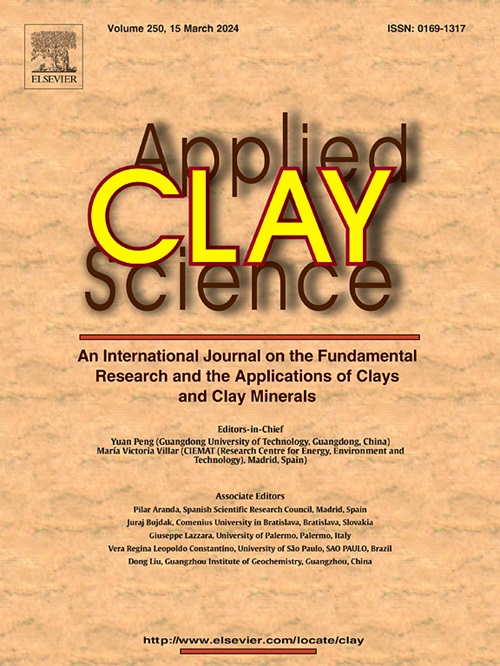Performance and mechanism of the controllable gaseous ClO2 generation with modified sepiolite-based porous materials
IF 5.3
2区 地球科学
Q2 CHEMISTRY, PHYSICAL
引用次数: 0
Abstract
ClO2 is a strong oxidizing fungicide widely used to protect people from bacterial diseases. It is of great urgency to develop a safe, fast and easy-to-use ClO2-based antimicrobial material to safeguard people's lives and health. In this work, the cheap natural porous ore sepiolite is adopted and modified by FeCl3 and AlCl3 as acidic activators. Several characterizations suggested the unchanged morphology and bond structure but the enlarged pore size improved the ClO2-releasing amount, which could reach to 13,903 μg with 25 % FeCl3-sepiolite and 12,670 μg with 15 % AlCl3-sepiolite. The separated FeCl3/AlCl3-sepiolite and NaClO2-sepiolite effectively extended the ClO2 releasing life. Meanwhile, increased temperature and humidity were beneficial for enhancing the ClO2 releasing amount. The mechanism investigation confirmed the ambient moisture promoted the contact to achieve ClO2 generation reactions. The above results showed that the well-developed metal chloride modification in sepiolite exhibits a good prospects in terms of industry and environment.

求助全文
约1分钟内获得全文
求助全文
来源期刊

Applied Clay Science
地学-矿物学
CiteScore
10.30
自引率
10.70%
发文量
289
审稿时长
39 days
期刊介绍:
Applied Clay Science aims to be an international journal attracting high quality scientific papers on clays and clay minerals, including research papers, reviews, and technical notes. The journal covers typical subjects of Fundamental and Applied Clay Science such as:
• Synthesis and purification
• Structural, crystallographic and mineralogical properties of clays and clay minerals
• Thermal properties of clays and clay minerals
• Physico-chemical properties including i) surface and interface properties; ii) thermodynamic properties; iii) mechanical properties
• Interaction with water, with polar and apolar molecules
• Colloidal properties and rheology
• Adsorption, Intercalation, Ionic exchange
• Genesis and deposits of clay minerals
• Geology and geochemistry of clays
• Modification of clays and clay minerals properties by thermal and physical treatments
• Modification by chemical treatments with organic and inorganic molecules(organoclays, pillared clays)
• Modification by biological microorganisms. etc...
 求助内容:
求助内容: 应助结果提醒方式:
应助结果提醒方式:


